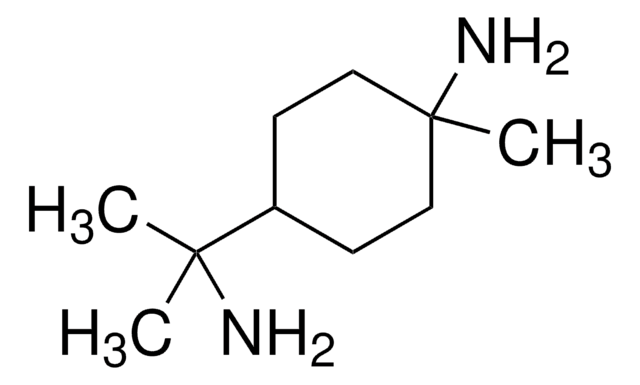すべての画像(2)
About This Item
化学式:
CH3CH2CH(NH2)CH2CH2NH2
CAS番号:
分子量:
102.18
Beilstein:
6796726
MDL番号:
UNSPSCコード:
12162002
PubChem Substance ID:
NACRES:
NA.23
おすすめの製品
法的情報
DYTEK is a registered trademark of Invista North America S.a.r.l.
シグナルワード
Danger
危険有害性情報
危険有害性の分類
Flam. Liq. 3 - Skin Corr. 1B
保管分類コード
3 - Flammable liquids
WGK
WGK 3
引火点(°F)
138.2 °F - closed cup
引火点(℃)
59 °C - closed cup
個人用保護具 (PPE)
Faceshields, Gloves, Goggles, type ABEK (EN14387) respirator filter
適用法令
試験研究用途を考慮した関連法令を主に挙げております。化学物質以外については、一部の情報のみ提供しています。 製品を安全かつ合法的に使用することは、使用者の義務です。最新情報により修正される場合があります。WEBの反映には時間を要することがあるため、適宜SDSをご参照ください。
消防法
第4類:引火性液体
第二石油類
危険等級III
非水溶性液体
Jan Code
381675-VAR:
381675-1L:
381675-250ML:
381675-25ML:
381675-BULK:
この製品を見ている人はこちらもチェック
Stephany Y Tzeng et al.
International journal of nanomedicine, 6, 3309-3322 (2012-01-10)
Biodegradable poly(ester amine) (PEA)-based and poly(amido amine) (PAA)-based nanoparticles were developed for efficient in vitro siRNA delivery to human umbilical vein endothelial cells (HUVECs). They were screened, characterized, and compared with traditionally studied DNA-containing particles. Several of the polymeric nanoparticles
Camila G Zamboni et al.
Journal of controlled release : official journal of the Controlled Release Society, 263, 18-28 (2017-03-30)
Hepatocellular carcinoma (HCC) is the third most deadly cancer in the US, with a meager 5-year survival rate of <20%. Such unfavorable numbers are closely related to the heterogeneity of the disease and the unsatisfactory therapies currently used to manage
Antonella Mangraviti et al.
ACS nano, 9(2), 1236-1249 (2015-02-03)
Biodegradable polymeric nanoparticles have the potential to be safer alternatives to viruses for gene delivery; however, their use has been limited by poor efficacy in vivo. In this work, we synthesize and characterize polymeric gene delivery nanoparticles and evaluate their
Jieun Hong et al.
Journal of controlled release : official journal of the Controlled Release Society, 200, 212-221 (2015-01-03)
Lineage conversion from one somatic cell type to another is an attractive approach for deriving specific therapeutic cell generation. In order to bypass inducing pluripotent stage, transdifferentiation/direct conversion technologies have been recently developed. We report the development of a direct
Feng Zhu et al.
ACS nano, 9(3), 2948-2959 (2015-02-11)
Organometallic halide perovskites CH3NH3PbX3 (X = I, Br, Cl) have quickly become one of the most promising semiconductors for solar cells, with photovoltaics made of these materials reaching power conversion efficiencies of near 20%. Improving our ability to harness the
ライフサイエンス、有機合成、材料科学、クロマトグラフィー、分析など、あらゆる分野の研究に経験のあるメンバーがおります。.
製品に関するお問い合わせはこちら(テクニカルサービス)















